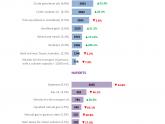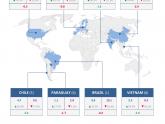Friday, 18 October 2024
In the first nine months of 2024, exports grew 15.5% compared to the same period in 2023 (reaching USD 59.1 billion), while imports fell 24.2% year-on-year (totalling USD 44.0 billion). As a result, the trade balance recorded a surplus of USD 15.1 billion.
HIGHLIGHTS
- Between January and September 2024, exports reached USD 59.1 billion, which represents a 15.5% year-on-year increase, explained by a 23.8% rise in the quantities exported that exceeded the 10.6% drop in prices.
- Imports amounted to USD 44.0 billion and fell 24.2% in year-on-year terms, resulting from a drop of 3.6% in prices and of 21.4% in the quantities imported. This is mainly due to lower prices of intermediate goods, fuels and lubricants, and a decrease in imported quantities of fuels and lubricants, capital goods and their parts and accessories. On the other hand, imports of motor vehicles rose, due to an increase in quantities.
- Consequently, the trade balance reached a surplus of USD 15.1 billion, while in the first nine months of 2023 a deficit of USD 6.9 billion had been recorded.

- Prominent are the increases in exports of soybean flour and pellets (USD 1.7 billion), crude petroleum oils (USD 1.4 billion), soybeans (USD 1.3 billion) and wheat (USD 1.2 billion, mainly to Brazil and Indonesia); while the greatest falls occurred in grains of barley (‐USD 194 million), lithium carbonates (‐USD 177 million), unwrought silver (‐USD 156 million) and virgin olive oil (‑USD 130 million).
- In relation to the soybean complex, the prices of beans (-21.8%), biodiesel (-19.2%), flour and pellets (-18.9%) and crude oil (-18.4%) decreased. As for the quantities exported, rises were recorded in those of beans (291.4%), flour and pellets (55.6%), crude oil (55.0%) and biodiesel (39.9%).
- Regarding imports, the most significant falls occurred in the purchases of soybeans (-USD 2.2 billion), liquefied natural gas (-USD 1.2 billion) and parts of telephones and devices for broadcasting, transmitting or receiving (-USD 936 million); while imports of vehicles for the transport of persons (USD 393 million), and of goods (USD 109 million) grew.

- The main export destinations were Brazil, with a 16,6% share, the EU, 10.0%, China, 8.5% and Chile, 7.9%. In turn, the most outstanding sources of imports were: Brazil, 22.8% of total imports, China, 17.9%, the EU, 15.2%, and the United States, 11.1%.
- The largest surpluses were obtained in trade with Chile (USD 4.2 billion), Vietnam (USD 2.0 billion), Peru (USD 1.7 billion), India (USD 1.6 billion), and Saudi Arabia (USD 1.0 billion); while the main deficits were registered with China (-USD 2.9 billion), Paraguay (-USD 1.7 billion) and Germany (-USD 1.4 billion).

Documentos relacionados:





